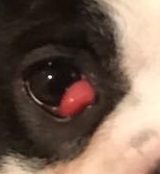Key Information About
Cherry Eye In Dogs
Any condition, including cherry eye in dogs, that threatens a dog's vision is vitally important and deserves an owner's quick attention.
Cherry Eye in dogs is a problem that is more likely to occur in younger dogs, up to two years of age, as well as in breeds that have flatter muzzles and prominent eyes, such as Pugs, Cocker Spaniels, Beagles, Pekingese, Boston Terriers, Bulldogs and ShihTzus.

In fact, these breeds tend to have greater susceptibility to eye disorders in general. We believe this tendency is genetically based.
What Exactly is Cherry Eye?
Before we go into that, it should be explained that dog's have a protective membrane in their lower eyelid called the third eyelid.
Owners may not see this part of the eye very often, if ever, unless they have one of the breeds with more prominent eyes, or there is something going wrong. If the eyeball is impacted or traumatized in some way, the membrane will slide across its surface to cover it.
In close proximity to the third eyelid membrane is a lymph gland that produces tears to keep the eyes lubricated and healthy.
Cherry eye in dogs is a condition that results if this lymph gland behind the third eyelid becomes inflamed and swollen causing it to pop out of its normal position. It is officially known as Nictitans Gland Prolapse.
What Are The Signs of Cherry Eye in Dogs?
Truth be told, it's hard to miss the appearance of cherry eye as it
is rather obvious. The most prominent feature is the unpleasant-looking,
bulbous, red swelling at the inner corner of the eye often described as
cherry-like in appearance - hence its name.

In addition to this, there may also be some accompanying discharge present.
If the condition is producing a significant amount of irritation, a dog will often be observed squinting or rubbing his paw across the affected eye. This is a sign of greater distress and in this case he should be taken to the vet right away for treatment.
Some pet owners may confuse the cherry eye condition with dog pink eye while others may be worried that the mass could be a more ominous growth. Because a dog's eyes are so important, anytime a worry exists, the best course of action is to seek a professional diagnosis to rule out other possibilities.
What Are The Causes of Cherry Eye?
Unfortunately, the causes of cherry eye in dogs are not crystal clear, though it may be triggered by a traumatic impact to the eye area, resulting in some bruising and swelling.
Infection may be another cause of the problem, particularly if any discharge is observed.
An allergy attack is another possibility. It may even be, as some suspect, the result of a genetic defect that results in the connective tissues in this area of the eye to be weaker and/or more vulnerable.
Treatment Remedies And Options
Although cherry eye in dogs has an alarming appearance, is not usually an emergency. That being said, prompt treatment of any pet disorder, is often the key to a successful outome.
If the red swelling has come on rather suddenly, it may go away if treated quickly with a simple home remedy - applying a warm compress and/or eye drops such as eyebright or Eye Heal.
Some pet owners may be tempted to try massage to pop the exposed gland back into place, but I wouldn't! Too risky.
A pet's eyes are precious and this technique if not done correctly and with extreme care can cause injury, or at the least a scratched eyeball.
But, if the symptoms don't start to show signs of clearing up quickly, it is best to have a veterinarian do a microscopic visual inspection of the mass to determine the exact cause.
Note: Eye redness and swelling can also be symptomatic of other eye diseases including conjunctivitis, corneal problems, glaucoma, tear duct issues, etc., so a professional diagnosis is important.
Generally, the first time cherry eye occurs, antibiotic or steroid preparations will be prescribed in the hopes of reducing the inflammation and/or preventing infection.
- Surgical Procedures
If this is unsuccessful, owners will often be advised to have the gland reattached by a surgical procedure. Surgery seems to be the most favored treatment approach in the long run because cherry eye is a condition that can be chronic.
Owners will want to become well-informed about the pros and cons of the following surgical procedures before deciding on this approach to cherry eye treatment:
- One is to reposition and reattach the gland with sutures.
- Another is to create and insert the gland into a pocket which is then closed with sutures.
- And a third, more radical approach, is to remove the gland itself.
However it should be noted that removing the gland will be accompanied by a loss of tear production, leaving the eye vulnerable to dry eye and related eye conditions.
Since cherry eye in dogs often reoccurs in susceptible breeds, pet owners may want to go to a veterinary ophthalmologist for evaluation from the get-go - in the event that surgery becomes necessary to aleviate the condition.
Eye surgery is a very delicate matter and owners are likely to feel more confident getting advice from a specialist for matters concerning their dog's eyes.
Prevention
When it comes to eye disorders, one of the simplest and easiest preventative measures is to make dog eye cleaning a regular habit. In addition to this, scheduled eye exams as prescribed by the vet are very necessary.
Once a dog has been successfully treated for canine cherry eye, it is important that the owners follow their vet's instructions precisely with respect to care.
If surgery has been done, this will likely include close observation of the affected eye to look for any indications of dry eye. In addition, owners may need to apply medications and attach an e-collar to their dog for a few days to guard against any adverse contact with the eye while it is healing.
Owners will usually be advised to keep a close watch on the other eye during their inspections as it is not uncommon for cherry eye to occur in both eyes. Sometimes, during the surgery to treat cherry eye, the gland in the unaffected eye may also be sutured as a precautionary measure.
If cherry eye reoccurs, the best course of action to protect the eye from further damage is to get it treated promptly.
Before You Go...
If you like the content of this page, as well as others on my site, please give it some love by clicking on the heart in the lower right hand corner. This helps me to keep providing enjoyable and useful content.
Thank you
Resource:
The American College of Veterinary Ophthalmologists
Read More Health Topics


